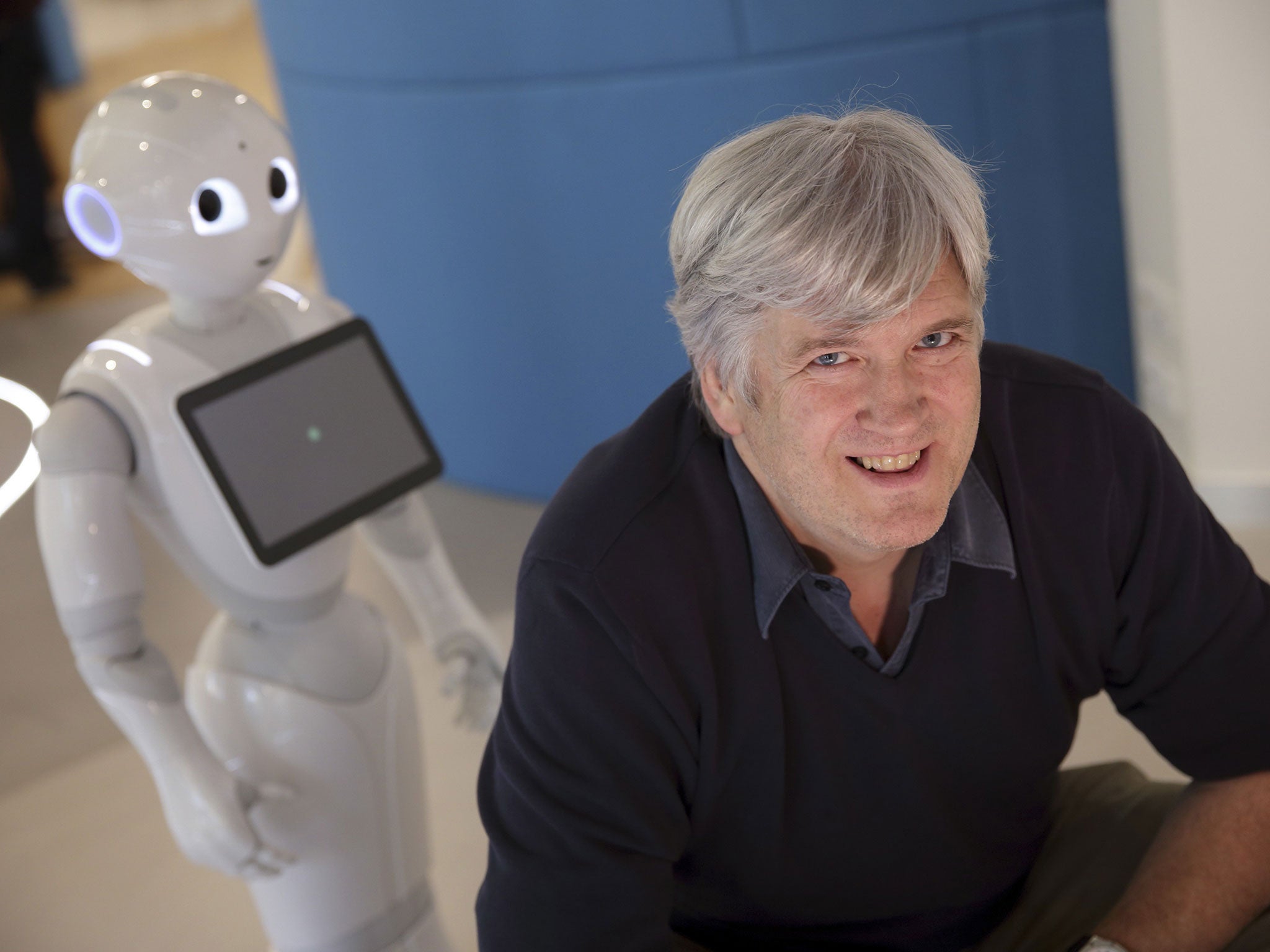‘You guys are foreign’: my date with robot that feels emotions
He’s called Pepper, stands 3ft 11in tall, and knows when you’re feeling sad. David McNeill tests the mettle of one of the new generation of androids being developed in Tokyo

Green-eyed and diminutive, Pepper works the crowd hard as he sings, dances and tries out his small talk. “You guys seem to be foreigners – where are you from?” he asks. When we tell him we’re Irish, he says: “Gosh, Europe has so many interesting countries. I’d like to go there some day.”
Okay, it’s not Shakespeare but then the Bard wasn’t a 28kg shiny box of circuits and sensors gliding around on wheels. Pepper is the latest in a long line of made-in-Japan battery-powered bipeds. Unlike most of them, however, he can carry out a conversation. He can even tell if you’re sad.
Telecom giant Softbank has wheeled out Pepper prototypes in its biggest Tokyo stores where he entertains children while mums and dads shop for iPhones. The robot bristles with sensors and uses artificial intelligence to understand facial expressions, gestures and vocal tones – its “emotional engine”.
The result is a pint-sized (3ft 11in) interactive charmer who speaks in the high voice of an anime star and tells bad jokes. “Ok, I can’t transform into a car or send laser beams from my eyes, but I can sing,” he says. When we say we’d prefer to chat he looks briefly puzzled, then launches into song anyway.
Unveiling the robot last month, Softbank’s billionaire founder and chief executive Masayoshi Son insisted Pepper is different from his predecessors. “People describe others as being robots because they have no emotions, no heart,” he said. “For the first time in human history, we’re giving a robot a heart, emotions.”

The unveiling of Pepper demonstrates that Japan’s love affair with humanoid machines shows no sign of cooling. The country’s space agency last year announced the dispatch of a pint-sized robot astronaut to outer space. “Kirobo”, partly built by Toyota Motor, had an unusual mission: talk to the human crew aboard the International Space Station.
The ultimate aim, however, is loftier. “We’re trying to help build a society where robots and humans can co-exist, says Fuminori Kataoka, the project’s general manager.
Then there is Asimo, billed as the planet’s most advanced humanoid robot – at least before Pepper arrived. Since debuting 14 years ago, Asimo has opened the New York Stock Exchange and played to audiences all over the world. In 2011, it served tea to Stephen Fry. Asimo can also play soccerand violin.
Faced with a real job, however, Asimo stumbled. Honda considered sending the robot to help with the aftermath of the 2011 Fukushima nuclear disaster, which left behind radiation deadly for humans. But engineers decided it was too sensitive and could fall over rubble. Honda then created a new prototype to survey the plant’s reactor.
Honda’s experience raises a key question: how useful are Japan’s robots? After all, if they can’t help during its worst modern disaster, what use are they?
The criticism in some senses misses the point: robots already do much of the heavy lifting in factories around Japan, displacing thousands of workers. With 360,000 of the world’s million industrial robots, Japan dominates the global market, which will be worth nearly 3 trillion yen (about £25bn) by the end of this decade, predicts the Japan Robot Association.
Japan’s engineers, however, are increasingly finding more uses for robots outside the factory floor, as so-called people-pleasers, and “welfare” robots. HAL, a bionic suit developed by Japanese company Cyberdyne, for example, received its global safety certificate in 2013, clearing the way for a worldwide marketing campaign.
The Hybrid Assistive Limb is a mechanical exoskeleton that boosts the strength of the wearer. In promotion videos, HAL-wearing pensioners rise Lazarus-like from wheelchairs for a stroll.
“Outside Japan robots are often depicted as villains,” says HAL inventor Yoshiyuki Sankai, who was inspired to build it after seeing paralysed hospital patients. “But to us they are friends.”
HAL is already in action at about 170 retirement homes and hospitals around Japan but its hefty annual leasing cost – about 1.8 million yen (£10,400) – will keep it out of the hands of ordinary pensioners for now. Riken Research Institute is trialling a mechanical care giver: a robot that lifts elderly patients off a futon and into a wheelchair or bath.
Development of robot assistants is being driven partly by Japan’s aging population. Human care-givers are in short supply and Japan has mostly shunned the solution found in other advanced countries: imported labour.
Japan’s Robot Policy Committee, under the auspices of the Ministry of Economy, Trade and Industry, helps promote the evolution of robots from industrial use to “consumer types”. Eventually, the aim is to commercialise them and sell them abroad.
There is another distinct thread running through Japan’s robot culture – their closeness to humans. Unlike many fictional robots in Western culture, robots in Japanese “manga” novels and movies are largely benign. One of Japan’s most famous fictional robots, Astro Boy, is run on nuclear power, helping to transform its image in the 1950s.
Masayoshi Son says he was inspired to create Pepper partly by spending his childhood watching Astro Boy cartoons. “Astro Boy was not able to experience feelings such as pain, sadness and happiness,” he said. “I thought it would be nice if robots and computers could figure out such feelings.”
Join our commenting forum
Join thought-provoking conversations, follow other Independent readers and see their replies
Comments
Bookmark popover
Removed from bookmarks